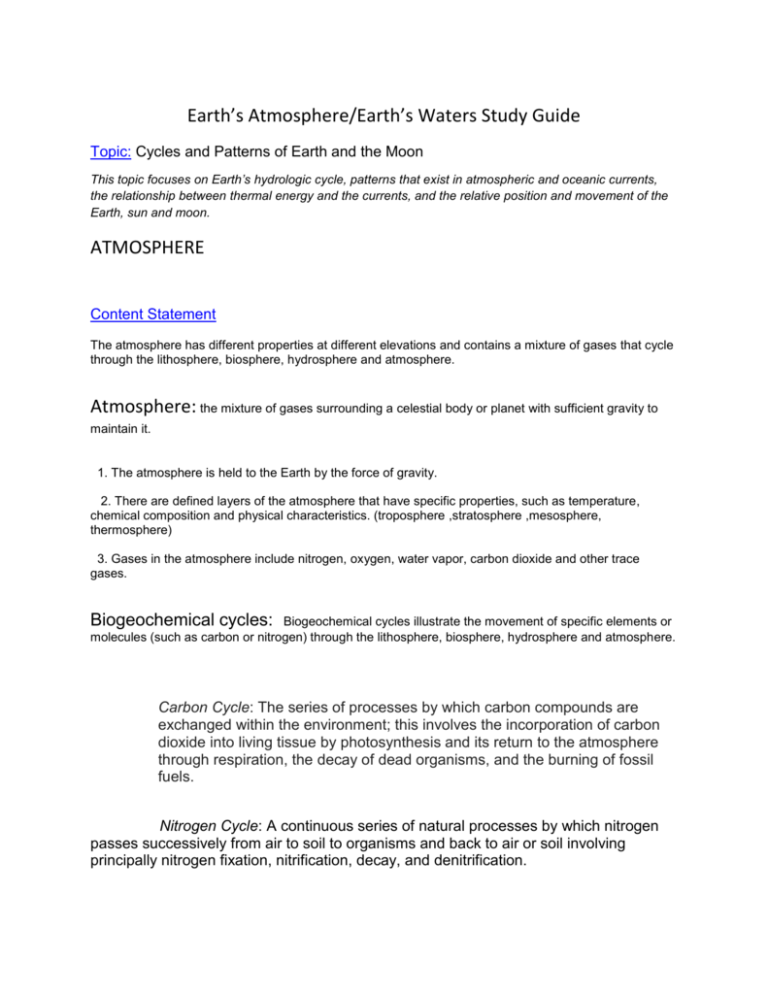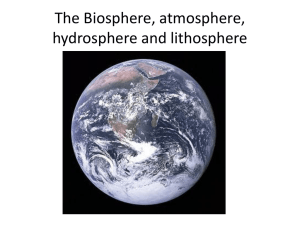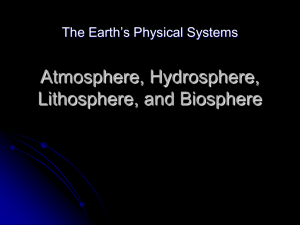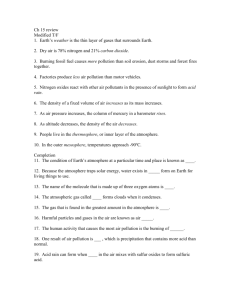Hydrologic Cycle
advertisement

Earth’s Atmosphere/Earth’s Waters Study Guide Topic: Cycles and Patterns of Earth and the Moon This topic focuses on Earth’s hydrologic cycle, patterns that exist in atmospheric and oceanic currents, the relationship between thermal energy and the currents, and the relative position and movement of the Earth, sun and moon. ATMOSPHERE Content Statement The atmosphere has different properties at different elevations and contains a mixture of gases that cycle through the lithosphere, biosphere, hydrosphere and atmosphere. Atmosphere: the mixture of gases surrounding a celestial body or planet with sufficient gravity to maintain it. 1. The atmosphere is held to the Earth by the force of gravity. 2. There are defined layers of the atmosphere that have specific properties, such as temperature, chemical composition and physical characteristics. (troposphere ,stratosphere ,mesosphere, thermosphere) 3. Gases in the atmosphere include nitrogen, oxygen, water vapor, carbon dioxide and other trace gases. Biogeochemical cycles: Biogeochemical cycles illustrate the movement of specific elements or molecules (such as carbon or nitrogen) through the lithosphere, biosphere, hydrosphere and atmosphere. Carbon Cycle: The series of processes by which carbon compounds are exchanged within the environment; this involves the incorporation of carbon dioxide into living tissue by photosynthesis and its return to the atmosphere through respiration, the decay of dead organisms, and the burning of fossil fuels. Nitrogen Cycle: A continuous series of natural processes by which nitrogen passes successively from air to soil to organisms and back to air or soil involving principally nitrogen fixation, nitrification, decay, and denitrification. WATER CYCLE Content Statement The hydrologic cycle illustrates the changing states of water as it moves through the lithosphere, biosphere, hydrosphere and atmosphere. Water Cycle / Hydrologic Cycle: The hydrologic cycle illustrates the changing states of water as it moves through the lithosphere, biosphere, hydrosphere and atmosphere. Surface water: is water on the surface of the planet such as in a stream, river, lake, wetland, or ocean. Ground water: Water beneath the earth's surface, often between saturated soil and rock, that supplies wells and springs. Porosity: Property of a solid which contains many minute channels or open spaces. Porosity is the fraction as a percent of the total volume occupied by these channels or spaces. Permeability: The ability of a membrane or other material to permit a substance to pass through it. Infiltration: the process where water enters small pore spaces between particles of soil and rocks.The downward movement of water through soil. 1. As water changes state and energy is transferred, it cycles from one sphere into another (e.g., water transfers from the hydrosphere to the atmosphere when evaporation occurs). 2. Ground water and surface water quality are important components of the hydrologic cycle. 3. Thermal energy is transferred as water changes state throughout the cycle. 4. The cycling of water in the atmosphere is an important part of weather patterns on Earth. 5. The rate at which water flows through soil and rock is dependent upon the porosity and permeability of the soil or rock. 6. Contamination can occur within any step of the hydrologic cycle. 7. Ground water is easily contaminated as pollution present in the soil or spilled on the ground surface moves into the ground water and impacts numerous water sources. 8. Identify drainage patterns and watersheds that contribute to the cycling of water. Human Impact/Activities: Contamination: Describes how rivers, lakes and groundwater can be depleted or polluted becoming less hospitable to life and even becoming unavailable or unsuitable for life. Point Source Pollution: is a single identifiable source of air, water, thermal, and noise or light pollution. Examples include ... oil refinery, wastewater discharge outlet... Non-Point Source Pollution: refers to both water and air pollution from diffuse or indirect sources. Nonpoint source water pollution affects a water body from sources such as polluted runoff from agricultural areas draining into a river, or wind-borne debris blowing out to sea. Nonpoint source air pollution affects air quality from sources such as smokestacks or car tailpipes. Greenhouse effect: refers to ability of certain atmospheric gases(CO2,water vapor, Nitric Oxide) to trap infrared heat and keep the planet relatively warm. Global Warming: the gradual increase of the temperature of the earth's lower atmosphere as a result of the increase in greenhouse gases since the Industrial Revolution. Ozone Depletion: due partly to unusually cold temperatures in the stratosphere above the Arctic, as colder stratospheric temperatures make ozone-destroying chemicals such as chlorine more active. SMOG: when hydrocarbons and nitrous oxides from auto emissions are exposed to sunlight, a photochemical reaction takes place that results in the formation of “bad” ozone and other irritating compounds. Deforestation: the process of clearing forests or the practice of routine clear-cutting to make new soil available for agricultural use. Deforestation can lead to erosion, drought, loss of biodiversity through extinction of plant and animal species, and increased atmospheric carbon dioxide. 1. Contamination can occur within any step of the hydrologic cycle. Ground water is easily contaminated as pollution present in the soil or spilled on the ground surface moves into the ground water and impacts numerous water sources. 2. Greenhouse gases (including water vapor), ozone (in the atmosphere and at Earth’s surface), and natural events/human activities can change the properties of the atmosphere. 3. Recognize human-made and natural factors that can change the properties of the atmosphere.








